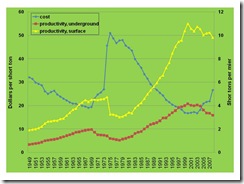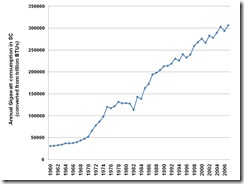As mentioned in Energy 101, on a BTU basis it can be said that coal sales are discounted by 95% when petroleum costs $100 a barrel and a short ton of coal only cost $25. However, on a pound-for-pound basis petroleum is almost twice as energy rich as is coal. At 20.754 million BTUs per short ton (2,000 lbs) of coal, the energy content of a pound of coal is 10,287 BTUs. In contrast, a gallon of gasoline at room temperature (72°F) weighs approximately 6.25 pounds. Given that a gallon of gasoline also contains 124,000 BTUs, it can also be said that a pound of gasoline contains 19,840 BTUs.
So why is coal so cheap? The answer is primarily because coal is a home-grown resource and because of surface mining techniques like “mountain top removal”. Did you know that the cost of a short ton of coal in 2007 was 34% less than what the same amount of coal cost in 1949? Furthermore, the average cost of a short ton of coal in 2008 was $26.62. Hmm, let me get this straight…for about the same price that I can purchase a pound and a half of fresh, locally and sustainably caught seafood I can also purchase 2,000 pounds of destructively harvested coal? Something is definitely fishy there!
It is largely because of the relatively cheap and accessible nature of coal that it supplies more than half of our nation’s electricity needs. And it is the cheap nature of coal that drives our excessive consumption of it. Continuing the food analogy theme prevalent throughout this website, a person who wears sweat pants all day (and that isn’t an athlete) is much more likely to over eat than when wearing tight-fitting clothing. Similarly, when energy is cheap we are much less likely to care about conserving it.
South Carolina provides a prime example of out of control electricity addiction, where electricity consumption has increased >800% since 1960! Think about that for a moment. Electricity usage in SC increased by almost 20% annually for forty straight-years, and yet we’re ready to protest on the Capital steps when the utilities want to raise rates by <5% a year? Don’t get me wrong; I don’t like to pay more for something than I have to. However, at some point both the market and morality eventually dictate that we should at least pay the true cost.
More than three-quarters of that electricity is consumed in buildings, with slightly more consumption in residential than commercial buildings. In SC, high per capita usage of electricity is attributed to widespread use of electricity for heating and cooling, particularly given high demand in the summer and low operational efficiency of electric heating in the winter. Nationally, SC also ranks low with respect to building insulation efficiency, a detrimental factor that contributed to the need to the creation of a “cash for caulkers” program in 2009. The flip side to low scores is that there is a lot of room for improvement, which is highlighted in detail in the Eco-Cents Home Energy Audit page.
